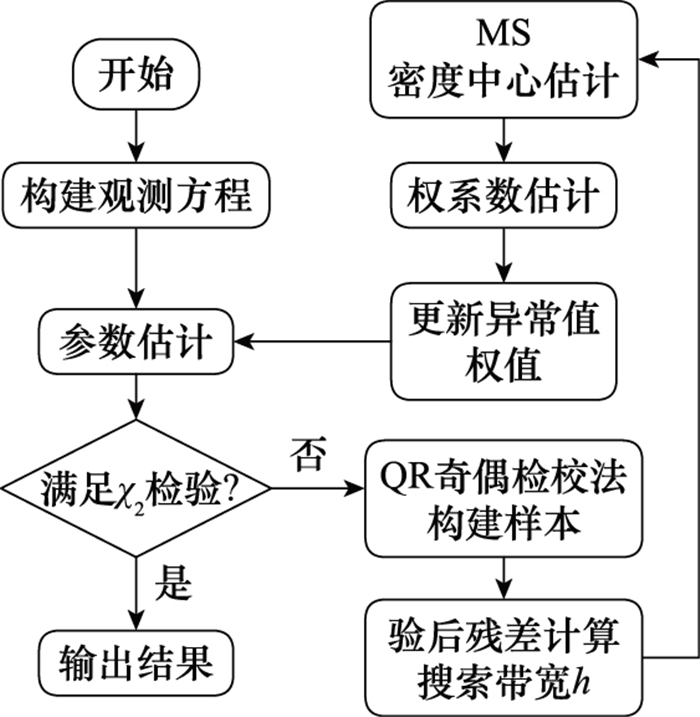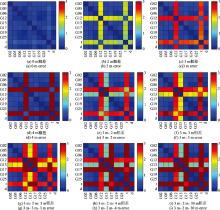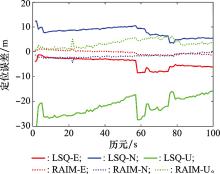| 1 |
HEWITSON S , WANG J . GNSS receiver autonomous integrity monitoring (RAIM) performance analysis[J]. GPS Solutions, 2006, 10 (3): 155- 170.
doi: 10.1007/s10291-005-0016-2
|
| 2 |
YANG Y X , XU J Y . GNSS receiver autonomous integrity monito-ring (RAIM) algorithm based on robust estimation[J]. Geodesy and Geodynamics, 2016, 7 (2): 117- 123.
doi: 10.1016/j.geog.2016.04.004
|
| 3 |
CHEN J , HUANG Z , RUI L I . Computation of satellite clock-ephemeris augmentation parameters for dual frequency multi constellation satellite-based augmentation system[J]. Journal of Systems Engineering and Electronics, 2018, 29 (6): 1111- 1123.
doi: 10.21629/JSEE.2018.06.01
|
| 4 |
TAN T N , KHENCHAF A , COMBLET F , et al. Robust-extended Kalman filter and long short-term memory combination to enhance the quality of single point positioning[J]. Applied Sciences, 2020, 10 (12): 4335.
doi: 10.3390/app10124335
|
| 5 |
SUN Y . RAIM-NET: a deep neural network for receiver autonomous integrity monitoring[J]. Remote Sensing, 2020, 12 (9): 1503.
doi: 10.3390/rs12091503
|
| 6 |
LUO S L , WANG L , TU R , et al. Satellite selection methods for multi-constellation advanced RAIM[J]. Advances in Space Research, 2020, 65 (5): 1503- 1517.
doi: 10.1016/j.asr.2019.12.015
|
| 7 |
SONG J H , JEE G I . Performance enhancement of land vehicle positioning using multiple GPS receivers in an urban area[J]. Sensors, 2016, 16 (10): 1688.
doi: 10.3390/s16101688
|
| 8 |
TITOUNI S , ROUABA H . Spectral transformation-based technique for reducing effect of limited pre-correlation bandwidth in the GNSS receiver filter in presence of noise and multipath[J]. Journal of Systems Engineering and Electronics, 2020, 31 (2): 252- 265.
doi: 10.23919/JSEE.2020.000003
|
| 9 |
SUN J K , NIU Z , ZHU B F . Fault detection and exclusion method for a deeply integrated BDS/INS system[J]. Sensors, 2020, 20 (7): 1844.
doi: 10.3390/s20071844
|
| 10 |
ZHANG K , PAPADIMITRATOS P . Fast multiple fault detection and exclusion (FM-FDE) algorithm for standalone GNSS receivers[J]. IEEE Open Journal of the Communications Society, 2021, 2, 217- 234.
doi: 10.1109/OJCOMS.2021.3050333
|
| 11 |
BANG E , MILNER C , MACABIAU C . Cross correlation effect of ARAIM test statistic on false alarm risk[J]. GPS Solutions, 2020, 24 (4): 107- 114.
doi: 10.1007/s10291-020-00997-w
|
| 12 |
SU X , ZHAN X M , NIU M R , et al. Receiver autonomous integrity monitoring (RAIM) performances of combined GPS/BeiDou/QZSS in urban canyon[J]. IEEE Trans.on Electrical and Electronic Engineering, 2014, 9 (3): 275- 281.
doi: 10.1002/tee.21967
|
| 13 |
LI L , WANG H , JIA C , et al. Integrity and continuity allocation for the RAIM with multiple constellations[J]. GPS Solutions, 2017, 21 (4): 1503- 1513.
doi: 10.1007/s10291-017-0627-4
|
| 14 |
GOTTSCHALG G , LEINEN S . Comparison and evaluation of integrity algorithms for vehicle dynamic state estimation in different scenarios for an application in automated driving[J]. Sensors, 2021, 21 (4): 1458.
doi: 10.3390/s21041458
|
| 15 |
WANG L Y , LI Z F , WANG N , et al. Real-time GNSS precise point positioning for low-cost smart devices[J]. GPS Solutions, 2021, 25 (2): 69- 84.
doi: 10.1007/s10291-021-01106-1
|
| 16 |
李臻, 宋丹, 张鹏飞, 等. 基于抗差扩展卡尔曼滤波和外推积累的RAIM方法[J]. 系统工程与电子技术, 2017, 39 (9): 2094- 2099.
|
|
LI Z , SONG D , ZHANG P F , et al. RAIM method based on robust extended Kalman filter and extrapolation accumulation[J]. Systems Engineering and Electonics, 2017, 39 (9): 2094- 2099.
|
| 17 |
PARKINSON B W , AXELRAD P . Autonomous GPS integrity monitoring using the pseudorange residual[J]. Navigation, 1988, 35 (2): 255- 274.
doi: 10.1002/j.2161-4296.1988.tb00955.x
|
| 18 |
KALAFUS R M , CHIN G Y . Performance measures of receiver-autonomous GPS integrity monitoring[J]. Institute of Navigation, 1988, 32 (2): 223- 229.
|
| 19 |
王煜东, 许承东, 郑学恩. 基于斜率加权的最小二乘RAIM算法研究[J]. 电光与控制, 2020, 27 (3): 13- 16, 64.
doi: 10.3969/j.issn.1671-637X.2020.03.003
|
|
WANG Y D , XU C D , ZHENG X E . An RAIM algorithm based on slope-weighted least square method[J]. Electronics Optics and Control, 2020, 27 (3): 13- 16, 64.
doi: 10.3969/j.issn.1671-637X.2020.03.003
|
| 20 |
SONG D S , SHI C , WANG Z D , et al. Correlation-weighted least squares residual algorithm for RAIM[J]. Chinese Journal of Aeronautics, 2020, 33 (5): 1505- 1516.
doi: 10.1016/j.cja.2019.12.012
|
| 21 |
STURZA , MARK A . Navigation system integrity monitoring using redundant measurements[J]. Navigation, 1988, 35 (4): 483- 501.
doi: 10.1002/j.2161-4296.1988.tb00975.x
|
| 22 |
MA X , YU K , MONTILLET J P , et al. Equivalence proof and performance analysis of weighted least squares residual method and weighted parity vector method in RAIM[J]. IEEE Access, 2019, 7, 97803- 97814.
doi: 10.1109/ACCESS.2019.2929073
|
| 23 |
ANGRISANO A , GAGLIONE S , CROCETTO N , et al. PANG-NAV: a tool for processing GNSS measurements in SPP, including RAIM functionality[J]. GPS Solutions, 2020, 24 (1): 19- 35.
doi: 10.1007/s10291-019-0935-y
|
| 24 |
张倩倩, 归庆明, 宫轶松. 卫星多故障探测和识别的独立分量分析法[J]. 测绘学报, 2017, 46 (6): 698- 705.
|
|
ZHANG Q Q , GUI Q M , GONG Y S . Multiple satellite faults detection and identification based on the independent component analysis[J]. Acta Geodaetica et Cartographica Sinica, 2017, 46 (6): 698- 705.
|
| 25 |
王文博, 徐颖. 基于稳健MM估计的REKF RAIM算法[J]. 系统工程与电子技术, 2021, 43 (1): 216- 222.
|
|
WANG W B , XU Y . REKF RAIM algorithm based on MM-estimation[J]. Systems Engineering and Electonics, 2021, 43 (1): 216- 222.
|
| 26 |
GU S , BEI J M , SHI C S , et al. RAIM algorithm based on fuzzy clustering analysis[J]. Computer Modeling in Engineering & Sciences, 2019, 119 (2): 281- 293.
|
| 27 |
HUI Z Q , JIN S F , XIA Y , et al. A mean shift segmentation morphological filter for airborne LiDAR DTM extraction under forest canopy[J]. Optics & Laser Technology, 2021, 136, 106728.
|
| 28 |
GUO P S , LIU Z , WANG J B . Radar group target recognition based on HRRPs and weighted mean shift clustering[J]. Journal of Systems Engineering and Electronics, 2020, 31 (6): 1152- 1159.
doi: 10.23919/JSEE.2020.000087
|
| 29 |
陶本藻, 姚宜斌, 施闯. 基于相关分析的粗差可区分性[J]. 武汉大学学报: 信息科学版, 2004, 29 (10): 881- 884.
|
|
TAO B Z , YAO Y B , SHI C . Distinguishability of outlier based on correlative analysis[J]. Geomatics and Information Science of Wuhan University, 2004, 29 (10): 881- 884.
|
| 30 |
LI Z , LI M , SHI C , et al. A new fuzzy-cluster-based cycle-slip detection method for GPS single-frequency observation[J]. Remote Sensing, 2019, 11 (24): 2896.
doi: 10.3390/rs11242896
|





